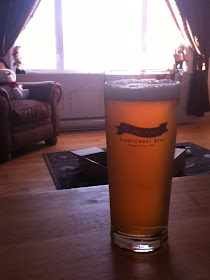I brewed my first Blonde Ale back in mid-2010, when I was still doing extract beers. I pretty much followed the recipe in Brewing Classic Styles, by Jamil Zainasheff and John Palmer.. it came out ok, but I wasn't completely satistified. About 6 months later, I tweaked the recipe a bit and came up with the all-grain Ten Dollar Blonde... the name was based on what the entire 5-gallon batch cost me to make. I had just started ordering bulk ingredients, and reused a washed yeast cake, so it was quite cheap. I found this beer was an improvement over the last Blonde, but thought it was still lacking a bit in the malty character that the style is known for.
So, in late October of this year, I brewed my third Blonde. I bumped up the Munich this time, and cut out the bit of Crystal malt I had in the last batch. A Blonde Ale should not have a caramel flavor/aroma... it should have a light to moderate malty sweetness, with a bit of optional fruitiness, according to the BJCP guidelines. I aimed for a bitterness on the high-end of the style, but still relatively low compared to other beers. The 10-minute Crystal hop addition is to provide a touch of fruity/spicy hop flavor, with the flameout Amarillo addition used to hopefully provide a bit of citrus aroma.
 Appearance: Poured with a moderate-sized, white, slightly creamy head that slowly dissipates to 1/4-finger. Body is a medium-golden color, correct for the style, with moderately-good clarity... a touch of haziness persists.
Appearance: Poured with a moderate-sized, white, slightly creamy head that slowly dissipates to 1/4-finger. Body is a medium-golden color, correct for the style, with moderately-good clarity... a touch of haziness persists.Smell: A light-moderate malty aroma is present; slightly sweet, but not caramelly. A slight touch of citrus from the Amarillo late-hop addition, but no more than that.
Taste: A nice, moderate-to-light malt taste; again, like the aroma, some sweetness from the malt. Low hop flavor (a bit fruity), with a light bitterness in the finish. Creamy and smooth. No diacetyl.
Mouthfeel: Medium-light bodied, with moderate carbonation.
Overall: A pretty easy-drinking beer, which is what I was going for (as the style calls for). A bit more hop character here compared to the Ten Dollar Blonde, but still not much present (ok). Wish I had saved a bottle to compare.
Recipe: OG 1.050, FG 1.010, IBU 25.3, SRM 4.9, Efficiency 78%, Batch size 5.5 gallons (brewed Oct 24, 2011)
Grains:
1. 3.05 kg Canadian 2-row
2. 682 g Munich malt
3. 454 g Carapils
4. 227 g Wheat malt
Hops:
1. Magnum - 14 g (9.2% AA) @ 60 min
2. Willamette - 11 g (4.8% AA) @ 60 min
3. Crystal - 42 g (1.6% AA) @ 10 min
4. Amarillo - 21 g @ 0 min
Misc.:
1/2 tsp yeast nutrient @ 15 min
1/2 tab Irish Moss @ 5 min
Yeast: Wyeast 1098 British (with a 1.5 L starter)
- 60-minute mash with 14.55 L of strike water (treated with 1/4 tab Campden), mashed in at 153 F. Sparged with ~5.5 gallons of 168 F water for a final volume of ~6.75 gallons into kettle. 60 minute boil.
- Chilled down to 65 F with copper immersion chiller. Pitched yeast at this temp, aerated by shaking for several minutes before and after. OG 1.050.
24/10/11 - Slight activity present in airlock by late evening.
25/10/11 - In AM, bubbling more than q second, temp 68 F. In afternoon, bubbling 2-3 times per second, temp 70 F. In PM, bubbling more than q second, temp 71 F.
26/10/11 - In AM, bubbling q 3 seconds, temp 68 F. Moved into water-heater room to keep temp up a bit.
13/11/11 - Bottled with 122 g table sugar, aiming for 2.5 vol CO2 for 5 gallons, with a max temp of 71 F reached. Bottled 4 x 22 oz, 16 x 500 mL, 21 x 12 oz. Put in room set at 70 F for 2 weeks to condition.
Looks good Shawn!
ReplyDeleteI agree , nothing to hide behind, what you see is what you get, and like you say, where paying strict attention to your yeast is paramount. How did the British yeast affect it do you think?
The 1098 is supposed to be the "mildest" of the English yeasts, in terms of flavor and aroma, anyway. I wasn't looking for a lot of character, but wanted a bit of tartness and fruitiness, which is how Wyeast describes the strain. I think that actually comes through with this beer.
ReplyDelete